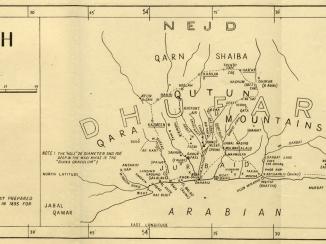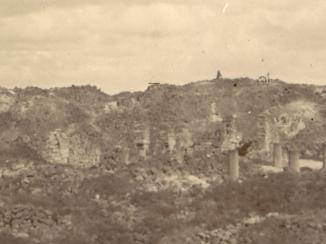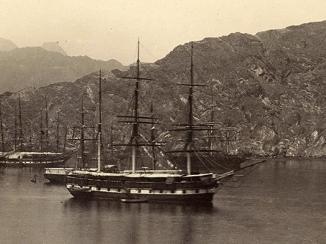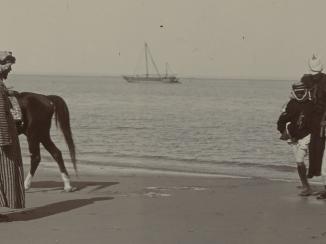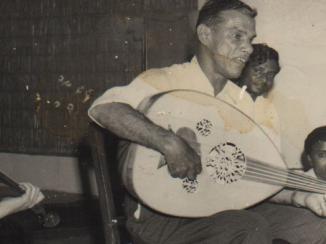'File 5/191 IV Individual slavery cases'
IOR/R/15/1/224
694 items in this record
Search within this record
The record is made up of 1 volume (338 folios). It was created in 1 Apr 1929-3 Jul 1934. It was written in English and Arabic. The original is part of the British Library: India Office The department of the British Government to which the Government of India reported between 1858 and 1947. The successor to the Court of Directors. Records and Private Papers Documents collected in a private capacity. .
About this record
- Content
The volume contains correspondence relating to instances of slavery on the Trucial Coast A name used by Britain from the nineteenth century to 1971 to refer to the present-day United Arab Emirates. . Of the eleven subjects contained in the volume, the first seven relate to the kidnapping and enslavement of individuals within the Trucial Coast A name used by Britain from the nineteenth century to 1971 to refer to the present-day United Arab Emirates. and Oman area, frequently by tribes from the interior. Cases 8 to 11 involve slaves imported into the Trucial Coast A name used by Britain from the nineteenth century to 1971 to refer to the present-day United Arab Emirates. and Oman region from the Baluchistan and Indian coast. These cases are similar to and in some instances linked to slavery cases in other Residency An office of the East India Company and, later, of the British Raj, established in the provinces and regions considered part of, or under the influence of, British India. volumes, in particular IOR/R/15/1/222 and IOR/R/15/1/223.
Subjects of note in the volume include the following:
Subject 1: The kidnapping of a Muscat subject who was taken to Dubai, and the efforts of the Residency An office of the East India Company and, later, of the British Raj, established in the provinces and regions considered part of, or under the influence of, British India. Agent at Sharjah (‘Īsá bin ‘Abd al-Latif), in correspondence with Shaikh of Dubai, to recover the man.
Subject 2: A slave trading case on the Batinah coast, mid-1929. In a statement made by one of the recovered slaves, the kidnapper was identified. Bertram Thomas ( Wazir Minister. to the Sultan of Muscat) wrote to confirm that he suspected the leader of the Yal Saad tribe (Shaikh Hilal) on the Batinah coast to be the suspect. However, Thomas advised against the arrest of Hilal, suggesting it would be 'fraught with serious political consequences', and could undermine the Sultan of Muscat's authority. This case is concurrent and directly associated with correspondence from Thomas found in file IOR/R/15/1/229. Notes at the front and end of subject 2's correspondence state that part of the correspondence was transferred to another file (IOR/R/15/1/229), although it appears to have been reinstated at a later date, before the file was bound.
Subject 4: An incident in mid-1929 of the kidnapping and enslavement of some inhabitants of Sharjah, and their transfer to Abu Dhabi by Manasir Bedouins. The matter prompted a strongly worded response from the Political Resident A senior ranking political representative (equivalent to a Consul General) from the diplomatic corps of the Government of India or one of its subordinate provincial governments, in charge of a Political Residency. (Lieutenant-Colonel Cyril Barrett) to the Shaikh of Abu Dhabi, demanding action to retrieve the slaves. Office notes written by the Residency An office of the East India Company and, later, of the British Raj, established in the provinces and regions considered part of, or under the influence of, British India. Secretary detailed the relative weakness of the Trucial Coast A name used by Britain from the nineteenth century to 1971 to refer to the present-day United Arab Emirates. shaikhs in relation to the Manasir tribe, which he described as being the 'irregular army' of Ibn Saud [‘Abd al-‘Azīz bin ‘Abd al-Raḥmān bin Fayṣal Āl Sa‘ūd]. The Secretary added that the Residency An office of the East India Company and, later, of the British Raj, established in the provinces and regions considered part of, or under the influence of, British India. Agent at Sharjah did not have any relations with the Manasir, and recommended a greater presence of the Resident or his Deputy in the area to 'tend to more cordial relations with all concerned.'
Subject 7: A 1929 kidnap of two Muscat subjects taken to the Trucial Coast A name used by Britain from the nineteenth century to 1971 to refer to the present-day United Arab Emirates. . Both individuals were recovered by the Shaikh of Abu Dhabi, under pressure from the Political Resident A senior ranking political representative (equivalent to a Consul General) from the diplomatic corps of the Government of India or one of its subordinate provincial governments, in charge of a Political Residency. . However a ransom (or 'redemption' payment) of 160 rupees Indian silver coin also widely used in the Persian Gulf. was made for one of the slaves. Correspondence followed over a two-year period, between the Political Resident A senior ranking political representative (equivalent to a Consul General) from the diplomatic corps of the Government of India or one of its subordinate provincial governments, in charge of a Political Residency. , the Residency An office of the East India Company and, later, of the British Raj, established in the provinces and regions considered part of, or under the influence of, British India. Agent at Sharjah, and the Muscat Government, relating to the question of liability for the reimbursement of the payment. The Political Residency An office of the East India Company and, later, of the British Raj, established in the provinces and regions considered part of, or under the influence of, British India. was reluctant to approve or encourage reimbursement to the Shaikh of Abu Dhabi for the payment, insisting that the British Government cannot 'recognise any payments for slavery, and [therefore] cannot ask the Political Agent A mid-ranking political representative (equivalent to a Consul) from the diplomatic corps of the Government of India or one of its subordinate provincial governments, in charge of a Political Agency. in this case to recover the money.'
Subject 10: A case in 1933 of a man in Dubai who was suspected of having kidnapped his employer's son in Karachi six years earlier. The man was detained with the Residency An office of the East India Company and, later, of the British Raj, established in the provinces and regions considered part of, or under the influence of, British India. Agent at Sharjah while correspondence between the Commissioner in Sind, Karachi, and the Political Resident A senior ranking political representative (equivalent to a Consul General) from the diplomatic corps of the Government of India or one of its subordinate provincial governments, in charge of a Political Residency. , attempted to ascertain if the man was the suspect from Karachi. The man was finally sent to Karachi via Bahrain, where he was arrested and imprisoned pending trial. Office notes in the subject file link the case to that of a young Indian boy imported to the Trucial Coast A name used by Britain from the nineteenth century to 1971 to refer to the present-day United Arab Emirates. in 1927 (IOR/R/15/1/223 – Subject 8: folios 87-205).
- Extent and format
- 1 volume (338 folios)
- Arrangement
The correspondence contained in the volume is arranged by subject, with eleven subjects in total included in the volume. Within each subject, correspondence is arranged chronologically from earliest at front to latest at rear. The subjects themselves are arranged chronologically, based on the earliest pieces of correspondence included in each, from earliest at the front to latest at the rear. A handwritten contents page on folio 3 lists and numbers the titles of these subjects, but not their corresponding page or folio number.
- Physical characteristics
Foliation: the foliation sequence commences at the front cover with 1 and terminates at the last folio with 338; these numbers are written in pencil, are circled, and are located in the top right corner of the recto The front of a sheet of paper or leaf, often abbreviated to 'r'. side of each folio.
Pagination: each of the subjects into which the volume is divided has its own internal pagination system, expressed as page number x of subject number y . Subject 10 is out of sequence, having been bound into the volume after subject 11.
- Written in
- English and Arabic in Latin and Arabic script
- Type
- Archival file
Archive information for this record
- Original held at
- British Library: India Office The department of the British Government to which the Government of India reported between 1858 and 1947. The successor to the Court of Directors. Records and Private Papers Documents collected in a private capacity.
- Access conditions
Unrestricted
- Archive reference
- IOR/R/15/1/224
- Former external reference(s)
- A Series: 5/191 IV
- Date(s)
- 1 Apr 1929-3 Jul 1934 (CE, Gregorian)
Access & Reference
History of this record
Related search terms
Use and share this record
- Share this record
- Cite this record in your research
'File 5/191 IV Individual slavery cases', British Library: India Office Records and Private Papers, IOR/R/15/1/224, in Qatar Digital Library <https://www.qdl.qa/archive/81055/vdc_100000000193.0x0000c5> [accessed 26 April 2024]
- Link to this record
https://www.qdl.qa/en/archive/81055/vdc_100000000193.0x0000c5
- IIIF details
This record has a IIIF manifest available as follows. If you have a compatible viewer you can drag the icon to load it.https://www.qdl.qa/en/iiif/81055/vdc_100000000193.0x0000c5/manifestOpen in Universal viewerOpen in Mirador viewerMore options for embedding images
Copyright: How to use this content
- Reference
- IOR/R/15/1/224
- Title
- 'File 5/191 IV Individual slavery cases'
- Pages
- 11r:12v
- Author
- Farajullah bin Mubarak
- Usage terms
- The copyright status is unknown. Please contact copyright@bl.uk with any information you have regarding this item.
- Reference
- IOR/R/15/1/224
- Title
- 'File 5/191 IV Individual slavery cases'
- Pages
- 34r:34v, 181r, 187r:187v, 208r:208v, 218r, 225r:225v
- Author
- Muscat and Oman, Council of Ministers
- Usage terms
- The copyright status is unknown. Please contact copyright@bl.uk with any information you have regarding this item.
- Reference
- IOR/R/15/1/224
- Title
- 'File 5/191 IV Individual slavery cases'
- Pages
- 75r, 81r, 166v:167v, 113r:127v, 134r:135v, 145r:146v, 166r:167v
- Author
- Āl Nahyān, Shaikh Shakhbut bin Sultān
- Usage terms
- The copyright status is unknown. Please contact copyright@bl.uk with any information you have regarding this item.
- Reference
- IOR/R/15/1/224
- Title
- 'File 5/191 IV Individual slavery cases'
- Pages
- 188r:188v
- Author
- al-Ḥārthī, Shaikh ‘Īsá bin Ṣāliḥ
- Usage terms
- Public Domain
- Reference
- IOR/R/15/1/224
- Title
- 'File 5/191 IV Individual slavery cases'
- Pages
- 241r:241v
- Author
- Ahmad bin Haidar
- Usage terms
- The copyright status is unknown. Please contact copyright@bl.uk with any information you have regarding this item.
- Reference
- IOR/R/15/1/224
- Title
- 'File 5/191 IV Individual slavery cases'
- Pages
- 261r:261v
- Author
- British India Steam Navigation Company Limited
- Copyright
- ©P&O Heritage
- Usage terms
- Creative Commons Non-Commercial Licence
- Reference
- IOR/R/15/1/224
- Title
- 'File 5/191 IV Individual slavery cases'
- Pages
- 131r:132v, 142r:142v, 193r:193v, 163r:163v
- Author
- Āl Nahyān, Shaikh Shakhbut bin Sultān
- Usage terms
- The copyright status is unknown. Please contact copyright@bl.uk with any information you have regarding this item.
- Reference
- IOR/R/15/1/224
- Title
- 'File 5/191 IV Individual slavery cases'
- Pages
- front, back, spine, edge, head, tail, front-i, 1ar:1cv, 2r:10v, 13r:33v, 35r:74v, 75v:80v, 81v:112v, 128r:130v, 133r:133v, 136r:136v, 136ar:136av, 137r:141v, 143r:144v, 147r:162v, 164r:164v, 164ar:164av, 165r:165v, 168r:180v, 181v:186v, 189r:192v, 194r:207v, 209r:217v, 218v:224v, 226r:240v, 242r:260v, 262r:338v, i-r:i-v, back-i
- Author
- East India Company, the Board of Control, the India Office, or other British Government Department
- Usage terms
- Open Government Licence






















































































































































































































































































































































































































































































































































































































































































































